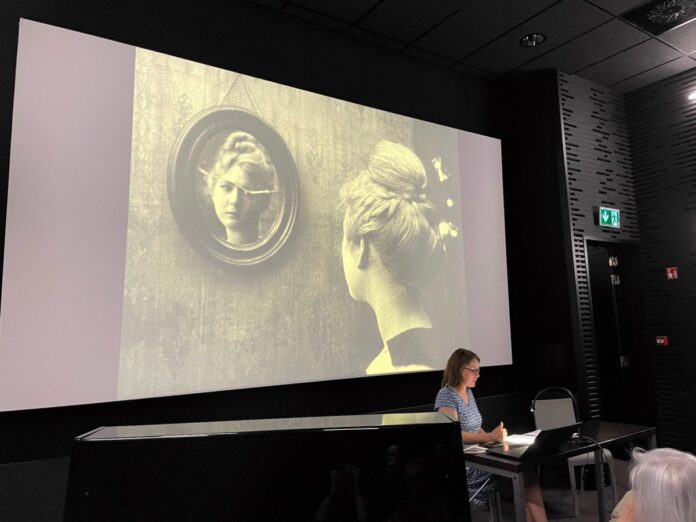“Is this really what you want to learn from the past?”
– Breaking Plates (Karen Pearlman, 2025)
Let the train take the strain they say, and so I did, curating my own idiosyncratic, mostly silent, tour of female film history this week – and all by rail. Please rest assured that no leading ladies were lashed to the tracks in the making of this movie. Nor is this post sponsored by Eurostar. I should be so lucky.
This cute preamble has simply delayed me telling you that I took the choo-choo to Brussels, birthplace of such 20th-century film icons as Audrey Hepburn, Agnès Varda (foreshadowing) and Chantal Akerman. So my first stop, naturally, was a pilgrimage to one of the most famous addresses in cinema history, 23 Quai de Commerce, 1080 Bruxelles, to pay homage to Akerman, Delphine Seyrig, and Jeanne Dielman herself by posing outside the door of the heroine’s apartment building wielding a potato peeler. Important feminist film praxis, and in the estimable company of Maggie Hennefeld to boot. All joking aside, there is a frisson to be felt standing on this spot, where Akerman filmed the exteriors for her 1975 masterpiece, and it is in a very pleasant corner of the city. Do visit, with or without kitchen implements. Don’t miss the Marguerite Duras quotes that pave the nearby park, and the gorgeous, watercolour-style mural of Dielman at her kitchen table by Spanish muralist Alba Fabre Sacristan. I recommend checking out her portfolio on Instagram: the subject matter of the majority of her work throws a different light on this apparently demure picture of a middle-aged woman in her housecoat.
The official reason for my jaunt was to attend the 12th Women and the Silent Screen conference, held this year at the Cinematek in Brussels and also at the University of Antwerp, on the themes of “form and feeling in silent cinema”. Which meant Seyrig was not going to be the only icon of the silver screen to pass before my eyes this week. The festival’s screening programme opened with a gorgeous, tinted, multisource restoration of Der Fremde Vogel (The Strange Bird, Urban Gad, 1911), a simple three-act tragedy designed to showcase the majestic form and feeling of Asta Nielsen, here in the second early phase of her stardom, newly transplanted to Germany and making films for international distribution. This is a slip of a thing, plot-wise, with Asta as a sophisticated New Yorker vacationing in the Spree Forest, who falls in love a boatman, who is both very much married, and not the kind of suitor her father had in mind. The current of the river rushes in one direction, to a tragic ending, with Nielsen ultimately rehearsing Ophelia, washed up among the waterlilies, a decade before she played Hamlet.
This oddly titled film has real momentum, not just from the river, but from Nielsen’s remarkable physical performance. Seeing Nielsen, framed fully head-to-toe, punting her boat further and further down the river, her lanky frame sheathed in tight black satin, her face framed by dark ringlets and the flowers on her hat, is utterly compelling. And then to see her dance, to pace up and down in her room, to embrace her lover… these may not be stunts or slapstick but this is pure physical film acting. The kinks and curves of her body speak a language all their own, let alone that expressive, elegant face. The silhouette of her clothes and the kohl around her eyes scream 1911, but otherwise you would be convinced she was about to stroll out of the screen. True film stars are timeless, especially the very first of them. Thanks to Maud Nelissen for her beautiful accompaniment. She knows the film well, and it showed.

There were papers this week on Asta Nielsen too, examining her acting technique, the publicity around her films, and the challenges of this restoration. The first day of papers contained many such gems, including a three-cornered panel on some women connected to acclaimed French filmmakers, and what we don’t know about them: Clara Auclair presented on Anne Carré, custodian of her husband Ben Carré’s legacy, Aurore Spiers on the women who helped to make Georges Méliès’s name, and his films, and Kristina Köhler on the unsung contribution of the Lumière sisters. Fascinating stuff.
Plenty of films on day two, also, starting with Zoe Beloff’s Life Forgotten (2025), a mixture of archive film, live-action, puppetry and polemic: the story of a little cinema in New York’s Lower East Side in the early 1900s, the eccentric showman who runs the place, and mostly the exploited female garment workers who attend the shows and see their precarious livelihood, and sexual harassment depicted on the screen. Harrowing moments when the story inevitably reaches the notorious Triangle Shirtwaist Factory fire, and also some stirring ones too, courtesy of the activism of real-life heroine Clara Lemlich, leader of the Uprising of 20,000.

Back into the (actual?) past we travelled for the evening with a triple-bill of silents, culminating in the jazz-age joyousness of Saxophon Susi (Karel Lamac, 1928), starring the divine Anny Ondra, which I have hymned in these pages before. But before then, there was elegantly elongated tragedy with Ruan Lingyu in the utterly fantastic The New Woman (Cai Chusheng, 1935), based on the true story of actress and writer Ai Xia, who killed herself in 1934. As did Lingyu shortly after the release of this, her penultimate film. This was a melodrama of the more-is-more school, which may weary some palates, but Lingyu is mesmerising as eve rand there are some heart-wrenching twists. Plus, one knockout fight sequence with Yin Xu as a butch factory worker headbutting the camera. Twice. Lingyu plays a beautiful novelist with a secret child, who is valued for her looks more than her words, but that value runs pretty cheap in the hands of malignant men.
Director Ruth Stonehouse provided a change of mood with the refreshing fish-out-of-water comedy Mary Ann in Society (1917), in which young Mary Ann Kelly (Stonehouse) gets to hang out at the Big House with Little Margaret for the day but finds the high life frustratingly on hi-jinks. This is a new discovery from the Eye Filmmuseum, and well worth a watch. Kudos to Stonehouse for triple-threating this captivating one-reeler as writer, director and star. There’s an intriguing moment when Mary Ann, stuffed into an uncomfortably frilly, impractically white frock stares disconsolately at her reflection in the mirror. A comic variation on a scene that would behighlighted in a couple of papers at the conference: Gabrielle conjuring a vision of herself as a bride in a brothel mirror in The Red Kimono (Dorothy Davenport Reid, 1925) and Eva gazing at a broken looking glass at a decisive moment in Lois Weber’s Shoes (1916).
The third day commence with a fascinating panel on the emotional affect of music to accompany silent film, with choice examples from eg The Red Kimono. Presenting: Jane Gaines and Benjamin Steege from Columbia on historical cue sheets and accompaniment theory, and the legendary Christine Gledhill, who explored the idea that “music intimates what language cannot express”. Dance, too, and I was very taken with a paper by Liz Czach on the work of dancer-turned-actress-who-dances Stacia Napierkowska. And also, Sarah Keller on how Shoes appeals to the audience via twin strategies of immersion and distraction, as we walk in Eva’s tattered boots and also refer to the film’s many imaginative and sociological diversions.
We are always a little distracted when watching silent films, often in productive ways, our eyes caught by the print or the restoration, the music, the presence of an unfamiliar actor or a familiar trope… the brain of the cinephile or scholar works in mysterious ways. Elif Rongen-Kaynakçi presented on a stencil-coloured Pathé Revue that showed Turkish women both wearing veils, and removing them, boldly in front of the camera, posing like fashion models. “Who ARE these women?” she asked, practising productive distracted spectatorship. Models, feminist clothing reform activists, aspiring actresses? And speaking of distractions on the theme of authenticity, Alice Maurice’s paper “In the blood or in the Greasepaint?” was fascinating on how actors such as Norma Talmadge performed racial otherness in ethnic makeups and simultaneously denied that they were doing anything other than during on their own innate talent and sympathy for their exotic characters.
My final film at WSS was the Brazilian melodrama Sangue Miniero (Humberto Mauro, 1930), a slightly disjointed but gorgeous drama about the two daughters of a rich industrialist, one adopted, and their romantic misadventures. I confess I was more distracted than immersed for this screening (likely thanks to the preceding days of scholarly stimulation) but it really was lovely and I would be keen to see again.

There was another film before that, one I have been keen to see for a while even though it’s a new one. Dancer-editor-academic-director Karen Pearlman’s Breaking Plates (2025) is inspired by the Cinema’s First Nasty Women project, and makes ingenious archival clips from those titles, in (telephone) conversation with contemporary live-action. Hard to describe, easy to love, this film is a kind of meta-hybrid drama-dance-doc about the making of a modern film inspired by Léontine, Mary Jane, Sarah Duhamel and co. It features Pearlman herself as the director, coaxing and commanding her actresses, led by the fantastic Violette Ayad (“no women will gaze out of windows in any of my movies”) to reproduce their predecessors’ marvellous mayhem, and gloriously sliding the “release” slider to maximum, letting her actors… go! Rare to see such joyful feminist revolution on screen, or such deep, loving engagement with silent film style. And what I liked most I think was that it showcased both free-spirited bodily anarchy in performance and supportive artistic collaboration, without any tension between the two. It moves, constantly, and at a galloping pace. It’s exhilarating and gleeful. More of this sort of thing please.
And in search of just that I travelled onwards to Paris, to catch, among other things, a programme of those Nasty Women shorts at the Cinématheque Française, waving a slightly wistful goodbye to a welcoming, lively and enriching conference. But refusing to gaze out of the train windows. Too much to write, anyway!
It felt medicinal, shall we say, to return to the Cinématheque – my last visit was in March 2020, say no more – and I have also been keen to revisit these femmes méchantes sur le gran écran. I was able to catch the programme titled Women at work (Do not disturb), which begins with my dearly beloved harassment-revenge double-bill of The Dairymaid’s Revenge and Finish of Mr Fresh (both Frank Armitage, 1899). Both of which were suitably in keeping with the theme of No Kings demonstration kicking off in the city at the very same hour. If you ask me.
Little Chrysia AKA Cunégonde bewitched me as ever, especially falling in love with her boss in Cunégonde aime son maître (1912), and Léontine’s epic naughtiness in Léontine devient trottin (1910) swept away the cobwebs of complacency. I blew kisses, as ever, to the striking nursemaids/suffragettes with their “A bas les patrons” placards in La Grève des nourrices (André Heuzé, 1910), but even more so to the organising babies, in the “Syndicat der Wickelkinder”. I had forgotten, I confess, how many animals are involved in these titles, from Rosalie’s monkey to a herd of dogs to the nursing cow in the aforementioned protest movie.
Maybe there are some days when all films feel like protest movies. At the panel afterwards, with NW curators Laura Horak, Maggie Hennefeld and Elif Rongen-Kaynakçi, a spectator asked whether some of these films may indeed have been made with anti-feminist intent, and indeed could still be read that way today. Well the panel answered this one more eloquently than I could, but to sum up, yes they probably were, and yes they could be read that way still, but the best films contain multiple paths to interpretation, and in the context of male-dominated cinema, the disruptive fantasies of destruction, lust, insurrection and narrative mayhem offered here provoke readings that that are too tempting to dismiss. I laugh with Cunégonde, you laugh at Cunégonde – either way we’re both laughing, and we can both acknowledge that it was Little Chrysia herself who made us do it. Vive les femmes méchantes.

Or, as a wise woman once said: “It’s natural for me to go from here to there, to say something and then its opposite, and to feel less trapped because I do not choose a single version of things.” No prizes for this segue, but I do think that the witty, joyful, angry, feminist Agnès Varda is my favourite film director. So, before I left Paris, I went to the Musée Carnavalet for the simply lovely exhibition Le Paris d’Agnès Varda de-ci, de-là, which brings together her photographs of Paris, how she filmed the city, returning again and again to her long-term home-cum-studio-cum-gallery on the Rue Daguerre, itself not a single version of anything. Time spent with Varda’s art, imagination, humanity is never wasted and I highly recommend this personal tour of her city. With 1962’s Cléo from 5 to 7 (the silent sequence of which is highlighted here) she made one of the all-time great Paris films. And with Daguerreotypes (1975) – shot within the range of an “umbilical” electrical cable plugged in at her own home – one of the best neighbourhood films, in which each resident answers questions on where they are from, when they arrived and why they came. Strange to think the latter, with its parade of local older, working women and housewives, was made in the same year that Akerman was shooting Jeanne Dielman, two different approaches to a displaced generation. Here, the work is beautiful and the joyous spirit with which it is made, utterly irresistible.
On that note, I hit up one more exhibition before catching the train home: Paris Noir at the Pompidou Centre is a tour of Black and Anti-colonialist art made in the capital from 1950-2000. No silent cinema here, but plenty of music, and some choice clips from films by the great Sarah Maldoror – a retrospective of her work accompanied the exhibition. And I smiled when I turned the corner to see an icon of cinema every bit as important as Jeanne Dielman: Mbissine Thérèse Diop as Diouana, the housemaid heroine of Ousmane Sembéne’s 1966 classic Black Girl.
There’s something strange cooking in the kitchen. Somewhere in the cinephile afterlife, Jeanne, Léontine, and Diouana may be smashing all the crockery they can get their hands on.




